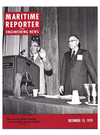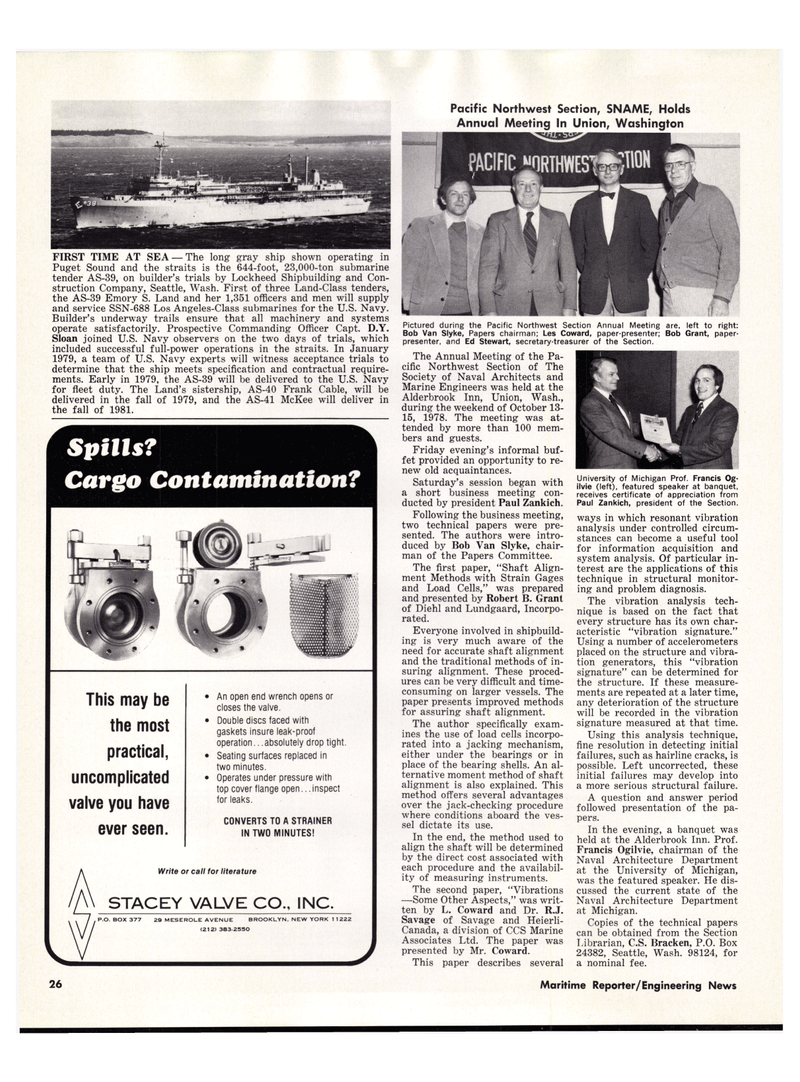
Page 30: of Maritime Reporter Magazine (December 15, 1978)
Read this page in Pdf, Flash or Html5 edition of December 15, 1978 Maritime Reporter Magazine
Spills?
Cargo Contamination?
FIRST TIME AT SEA — The long gray ship shown operating in
Puget Sound and the straits is the 644-foot, 23,000-ton submarine tender AS-39, on builder's trials by Lockheed Shipbuilding and Con- struction Company, Seattle, Wash. First of three Land-Class tenders, the AS-39 Emory S. Land and her 1,351 officers and men will supply and service SSN-688 Los Angeles-Class submarines for the U.S. Navy.
Builder's underway trails ensure that all machinery and systems operate satisfactorily. Prospective Commanding Officer Capt. D.Y.
Sloan joined U.S. Navy observers on the two days of trials, which included successful full-power operations in the straits. In January 1979, a team of U.S. Navy experts will witness acceptance trials to determine that the ship meets specification and contractual require- ments. Early in 1979, the AS-39 will be delivered to the U.S. Navy for fleet duty. The Land's sistership, AS-40 Frank Cable, will be delivered in the fall of 1979, and the AS-41 McKee will deliver in the fall of 1981.
This may be the most practical, uncomplicated valve you have ever seen.
An open end wrench opens or closes the valve.
Double discs faced with gaskets insure leak-proof operation... absolutely drop tight.
Seating surfaces replaced in two minutes.
Operates under pressure with top cover flange open... inspect for leaks.
CONVERTS TO A STRAINER
IN TWO MINUTES!
Write or call for literature
STACEY VALVE CO., INC.
P.O. BOX 377 29 MESEROLE AVENUE BROOKLYN. NEW YORK 1 1222 (212) 383 2530
Pictured during the Pacific Northwest Section Annual Meeting are, left to right:
Bob Van Slyke, Papers chairman; Les Coward, paper-presenter; Bob Grant, paper- presenter, and Ed Stewart, secretary-treasurer of the Section.
The Annual Meeting of the Pa- cific Northwest Section of The
Society of Naval Architects and
Marine Engineers was held at the
Alderbrook Inn, Union, Wash., during the weekend of October 13- 15, 1978. The meeting was at- tended by more than 100 mem- bers and guests.
Friday evening's informal buf- fet provided an opportunity to re- new old acquaintances.
Saturday's session began with a short business meeting con- ducted by president Paul Zankich.
Following the business meeting, two technical papers were pre- sented. The authors were intro- duced by Bob Van Slyke, chair- man of the Papers Committee.
The first paper, "Shaft Align- ment Methods with Strain Gages and Load Cells," was prepared and presented by Robert B. Grant of Diehl and Lundgaard, Incorpo- rated.
Everyone involved in shipbuild- ing is very much aware of the need for accurate shaft alignment and the traditional methods of in- suring alignment. These proced- ures can be very difficult and time- consuming on larger vessels. The paper presents improved methods for assuring shaft alignment.
The author specifically exam- ines the use of load cells incorpo- rated into a jacking mechanism, either under the bearings or in place of the bearing shells. An al- ternative moment method of shaft alignment is also explained. This method offers several advantages over the jack-checking procedure where conditions aboard the ves- sel dictate its use.
In the end, the method used to align the shaft will be determined by the direct cost associated with each procedure and the availabil- ity of measuring instruments.
The second paper, "Vibrations —Some Other Aspects," was writ- ten by L. Coward and Dr. R.J.
Savage of Savage and Heierli-
Canada, a division of CCS Marine
Associates Ltd. The paper was presented by Mr. Coward.
This paper describes several
University of Michigan Prof. Francis Og- ilvie (left), featured speaker at banquet, receives certificate of appreciation from
Paul Zankich, president of the Section. ways in which resonant vibration analysis under controlled circum- stances can become a useful tool for information acquisition and system analysis. Of particular in- terest are the applications of this technique in structural monitor- ing and problem diagnosis.
The vibration analysis tech- nique is based on the fact that every structure has its own char- acteristic "vibration signature."
Using a number of accelerometers placed on the structure and vibra- tion generators, this "vibration signature" can be determined for the structure. If these measure- ments are repeated at a later time, any deterioration of the structure will be recorded in the vibration signature measured at that time.
Using this analysis technique, fine resolution in detecting initial failures, such as hairline cracks, is possible. Left uncorrected, these initial failures may develop into a more serious structural failure.
A question and answer period followed presentation of the pa- pers.
In the evening, a banquet was held at the Alderbrook Inn. Prof.
Francis Ogilvie, chairman of the
Naval Architecture Department at the University of Michigan, was the featured speaker. He dis- cussed the current state of the
Naval Architecture Department at Michigan.
Copies of the technical papers can be obtained from the Section
Librarian, C.S. Bracken, P.O. Box 24382, Seattle, Wash. 98124, for a nominal fee.
Pacific Northwest Section, SNAME, Holds
Annual Meeting In Union, Washington reason to put our equipment to work for you. iiGnng<.niinoii6os2sUA». Maritime Reporter/Engineering News

 29
29

 31
31
